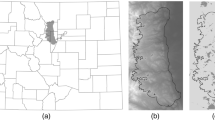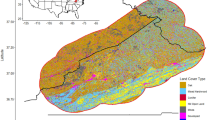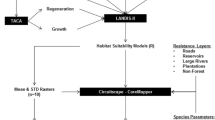Abstract
Prioritizing habitat for animal conservation in heterogeneous landscapes requires an understanding of where animal occurrence coincides with human influences on demographic performance. We related broad-scale patterns of occurrence with risk of mortality among female Rocky Mountain elk (Cervus elaphus) in a human-modified landscape to develop a spatially-explicit framework for animal conservation at the landscape level. Variability in the spatial pattern of elk occurrence was driven by preference for specific habitat types as well as responses to human activity. In contrast, risk of mortality was a function of human modification of the landscape with little variation explained by habitat. Proximity to industrial development was associated with increased risk of mortality whereas proximity to residences and agricultural structures was associated with decreased risk. Individual-level results revealed added complexity, whereby risk of mortality was associated with a consistent pattern of occurrence relative to industrial development, yet the association between risk and occurrence relative to structures was highly variable and likely a function of disparate land-use priorities. Approaches to managing human-mediated risk at the landscape level are most effective when they decompose human activity into constituent parts influencing risk, and when individual variation relative to the population response is investigated. Conservation interventions need to target factors that have a consistent influence across the population rather than risk uncertainty that would arise from targeting factors that influence individuals in variable or situation-specific ways. The spatial tools developed herein provide guidance for sustainable landscape planning in the study area, while the concept of linking occurrence and demographic performance within a hierarchical modeling framework has general application for animal conservation in landscapes subject to change, human-caused or otherwise.





Similar content being viewed by others
References
Aldridge CL, Boyce MS (2007) Linking occurrence and fitness to persistence: habitat based approach for endangered greater sage-grouse. Ecol Appl 17:508–526
Allison PD (1995) Survival analysis using SAS: a practical guide. SAS Institute Inc., Cary
Berger J (2007) Fear, human shields, and the redistribution of prey and predators in protected areas. Biol Lett 3:620–623
Bolnick DI, Svanbäck R, Fordyce JA, Yang LH, Davis JM, Hulsey CD, Forister ML (2003) The ecology of individuals: incidence and implications of individual specialization. Am Nat 161:1–28
Boyce MS (2006) Scale for resource selection functions. Diversity Distrib 12:269–276
Cameron RD, Reed DJ, Dau JR, Smith WT (1992) Redistribution of calving caribou in response to oil field development on the Arctic slope of Alaska. Arctic 45:338–342
Chalfoun AD, Martin TE (2007) Assessments of habitat preferences and quality depend on spatial scale and metrics of fitness. J Appl Ecol 44:983–992
Cole EK, Pope MD, Anthony RG (1997) Effects of road management on movement and survival of Roosevelt elk. J Wildl Manage 61:1115–1126
Conner MM, White GC, Freddy DJ (2001) Elk movement in response to early-season hunting in northwest Colorado. J Wildl Manage 65:926–940
Cook JG, Johnson BK, Cook RC, Riggs RA, Delcurto T, Bryant LD, Irwin LL (2004) Effects of summer-autumn nutrition and parturition date on reproduction and survival of elk. Wildl Monogr 155:1–61
Cox DR (1972) Regression models and life-tables. J R Stat Soc Ser B, Stat Method 34:187–220
Cross PC, Cole EK, Dobson AP, Edwards WH, Hamlin KL, Luikart G, Middleton AD, Scurlock BM, White PJ (2010) Probable causes of increasing brucellosis in free-ranging elk of the Greater Yellowstone Ecosystem. Ecol Appl 20:278–288
Delibes M, Gaona P, Ferreras P (2001) Effects of an attractive sink leading into maladaptive habitat selection. Am Nat 158:277–285
Dzialak MR, Harju SM, Osborn RG, Wondzell JJ, Hayden-Wing LD, Winstead JB, Webb SL (2011) Prioritizing conservation of ungulate calving resources in multiple-use landscapes. PLoS ONE 6:e14597. doi:10.1371/journal.pone.0014597
Energy Policy Act (2005) http://www.epa.gov/oust/fedlaws/publ_109-058.pdf
Estes JA, Riedman ML, Staedler MM, Tinker MT, Lyon BE (2003) Individual variation in prey selection by sea otters: patterns, causes, and implications. J Anim Ecol 72:144–155
Fuller AK, Harrison DJ (2010) Movement paths reveal scale-dependent habitat decisions by Canada lynx. J Mammal 91:1269–1279
Gillies CS, Hebblewhite M, Nielsen SE, Krawchuk MA, Aldridge CL, Friar JL, Saher DJ, Stevens CE, Jerde CL (2006) Application of random effects to the study of resource selection by animals. J Anim Ecol 75:887–898
Gordon IJ, Hester AJ, Festa-Bianchet M (2004) The management of wild large herbivores to meet economic, conservation and environmental objectives. J Appl Ecol 41:1021–1031
Haggerty JH, Travis WR (2006) Out of administrative control: absentee owners, resident elk and the shifting nature of wildlife management in southwestern Montana. Geoforum 37:816–830
Harju SM, Dzialak MR, Taylor RC, Hayden-Wing LD, Winstead JB (2010) Thresholds and time lags in the effects of energy development on greater sage-grouse populations. J Wildl Manage 74:437–448
Harju SM, Dzialak MR, Osborn RG, Hayden-Wing LD, Winstead JB (2011) Conservation planning using resource selection models: altered selection in the presence of human activity changes spatial prediction of resource use. Anim Conserv 14. doi:10.1111/j.1469-1795.2011.00456.x
Hayes SG, Leptich DJ, Zager P (2002) Proximate factors affecting male elk hunting mortality in northern Idaho. J Wildl Manage 66:491–499
Hebblewhite M, Merrill E (2008) Modelling wildlife-human relationships for social species with mixed-effects resource selection models. J Appl Ecol 45:834–844
Hebblewhite M, Merrill EH, McDonald TL (2005) Spatial decomposition of predation risk using resource selection functions: an example in a wolf-elk predator–prey system. Oikos 111:101–111
Hemborg HT (1998) Spanish peak field, Las Animas County, Colorado: geologic setting and early development of a coalbed methane reservoir in the central Raton Basin, Colorado. Geological Survey, Dept Nat Res, Res Series 33
Hudson RJ, Haigh JC (2002) Physical and physiological adaptations. In: Toweill DE, Thomas JW (eds) North American elk: ecology and management. Smithsonian Institution Press, Washington, DC, pp 199–257
Hunt GL Jr (1972) Influence of food distribution and human disturbance on the reproductive success of herring gulls. Ecology 53:1051–1061
Johnson DH (1980) The comparison of usage and availability measurements for evaluating resource preference. Ecology 61:65–71
Kauffman MJ, Varley N, Smith DW, Stahler DR, MacNulty DR, Boyce MS (2007) Landscape heterogeneity shapes predation in a newly restored predator-prey system. Ecol Lett 10:690–700
Kiesecker JM, Copeland H, Pocewicz A, McKenney B (2010) Development by design: blending landscape-level planning with mitigation hierarchy. Front Ecol Environ 8:261–266
Laliberte AS, Ripple WJ (2004) Range contractions of North American carnivores and ungulates. BioSci 54:123–138
Letcher BH, Priddy JA, Walters JR, Crowder LB (1998) An individual-based, spatially-explicit simulation model of the population dynamics of the endangered red-cockaded woodpecker, Picoides borealis. Biol Conserv 86:1–14
Littell RC, Milliken GA, Stroup WW, Wolfinger RD, Schnabenberger O (2007) SAS for mixed models, second edn. SAS Institute Inc, Cary
Manly BFJ, McDonald LL, Thomas DL, McDonald TL, Erickson WP (2002) Resource selection by animals: statistical design and analysis for field studies. Kluwer Academic Publishers, Norwell
McAlpine CA, Seabrook LM, Rhodes JR, Maron M, Smith C, Bowen ME, Butler SA, Powell O, Ryan JG, Fyfe CT, Adams-Hosking C, Smith A, Robertson O, Howes A, Cattarino L (2010) Can a problem-solving approach strengthen landscape ecology’s contribution to sustainable landscape planning? Landscape Ecol 25:1155–1168
McCorquodale SM, Wiseman R, Marcum CL (2003) Survival and harvest vulnerability of elk in the Cascade Range of Washington. J Wildl Manage 67:248–257
McLoughlin PD, Dunford JS, Boutin S (2005) Relating predation mortality to broad-scale habitat selection. J Anim Ecol 74:701–707
McLoughlin PD, Boyce MS, Coulson T, Clutton-Brock T (2006) Lifetime reproductive success and density-dependent multi-variable resource selection. Proc R Soc B 273:1449–1454
Nams VO (1996) The VFractal: a new estimator for fractal dimension of animal movement paths. Landscape Ecol 11:289–297
Nams VO (2005) Using animal movement paths to measure response to spatial scale. Oecologia 143:179–188
Naugle DE, Aldridge CL, Walker BL, Cornish TE, Moynahan BJ, Holloran MJ, Brown K, Johnson GD, Schmidtmann ET, Mayer RT, Kato CY, Matchett MR, Christiansen TJ, Cook WE, Creekmore T, Falise RD, Rinkes T, Boyce MS (2004) West Nile virus: pending crisis for greater sage-grouse. Ecol Lett 7:704–713
Nellemann C, Cameron RD (1998) Cumulative impacts of an evolving oil-field complex on the distribution of calving caribou. Can J Zool 76:1425–1430
Nielsen SE, Stenhouse GB, Boyce MS (2006) A habitat-based framework for grizzly bear conservation in Alberta. Biol Conserv 130:217–229
Pärt T, Arlt D, Villard MA (2007) Empirical evidence for ecological traps: a two-step model focusing on individual decisions. J Ornith 148:327–332
Pettifor RA, Caldow RWG, Rowcliffe JM, Goss-Custard JD, Black JM, Hodder KH, Houston AI, Lang A, Webb J (2000) Spatially-explicit, individual-based, behavior models of the annual cycle of two migratory goose populations. J Appl Ecol 37:103–135
SAS Institute (2008) SAS/STAT 9.2 user’s guide. SAS Institute Inc., Cary
Sawyer H, Nielson RM, Lindzey F, McDonald LL (2006) Winter habitat selection of mule deer before and during development of a natural gas field. J Wildl Manage 70:396–403
Sawyer H, Kauffman MJ, Nielson RM, Horne JS (2009) Identifying and prioritizing ungulate migration routes for landscape-level conservation. Ecol Appl 19:2016–2025
Smith T, Smith B, Ryan MAK (2003) Survival analysis using Cox proportional hazards modeling for single and multiple event time data. In: Proceedings of the twenty-eighth annual SAS users group international conference, SAS Institute, Inc, Cary, paper 254-28
Stalling DH, Wolfe GJ, Crockett DK (2002) Regulating the hunt: balancing the complexities of elk vulnerability. In: Toweill DE, Thomas JW (eds) North American elk: ecology and management. Smithsonian Institution Press, Washington, DC, pp 749–791
Stireman J, Dyer LA, Matlock M (2005) Top-down forces in managed versus unmanaged habitats. In: Barbosa P, Castellanos I (eds) Ecology of predator-prey interactions. Oxford University Press, Oxford, pp 303–323
Thompson MJ, Henderson RE (1998) Elk habituation as a credibility challenge for wildlife professionals. Wildl Soc Bull 26:477–483
Turner MG (1989) Landscape ecology: the effect of pattern on process. Annu Rev Ecol Syst 20:171–197
Unsworth JW, Kuck L, Scott MD, Garton EO (1993) Elk mortality in the Clearwater drainage of northcentral Idaho. J Wildl Manage 57:495–502
Van Horne B (1983) Density as a misleading indicator of habitat quality. J Wildl Manage 47:893–901
Visual Learning Systems (2008) Feature analyst® 4.2 for ArcGIS® reference manual. Visual Learning Systems, Inc., Missoula
Vitt A (2007) Trinchera data analysis unit E-33, game management units 83, 85, 140, 851, elk management plan. Colorado Division of Wildlife, Pueblo
Walker BL, Naugle DE, Doherty KE (2007) Greater-sage-grouse population response to energy development and habitat loss. J Wildl Managet 71:2644–2654
Weaver JL, Paquet PC, Ruggiero LF (1996) Resilience and conservation of large carnivores in the Rocky Mountains. Conserv Biol 10:964–976
Webb SL, Riffell SK, Gee KL, Demarais S (2009) Using fractal analyses to characterize movement paths of white-tailed deer and response to spatial scale. J Mammal 90:1210–1217
Webb SL, Dzialak MR, Wondzell JJ, Harju SM, Hayden-Wing LD, Winstead JB (2011) Survival and cause-specific mortality of female Rocky Mountain elk exposed to human activity. Pop Ecol 53. doi:10.1007/s10144-010-0258-x
Western Regional Climate Center (2010) Available from http://www.wrcc.dri.edu/coopmap/. Accessed June 2010
Wiens JA (1989) Spatial scaling in ecology. Funct Ecol 3:385–397
Wiens JA (2009) Landscape ecology as a foundation for sustainable conservation. Landscape Ecol 24:1053–1065
Wu J (2008) Making the case for landscape ecology: an effective approach to urban sustainability. Landscape J 27:41–50
Wu J, Hobbs R (2002) Key issues and research priorities in landscape ecology: an idiosyncratic synthesis. Landscape Ecol 17:355–365
Acknowledgments
Pioneer Natural Resources Company funded this work. We thank the Colorado Division of Wildlife for providing direction during the course of the study, landowners in Raton Basin who participated in this effort, and C. Hedley and three anonymous reviewers for helpful comments on earlier drafts.
Author information
Authors and Affiliations
Corresponding author
Rights and permissions
About this article
Cite this article
Dzialak, M.R., Webb, S.L., Harju, S.M. et al. The spatial pattern of demographic performance as a component of sustainable landscape management and planning. Landscape Ecol 26, 775–790 (2011). https://doi.org/10.1007/s10980-011-9607-1
Received:
Accepted:
Published:
Issue Date:
DOI: https://doi.org/10.1007/s10980-011-9607-1




